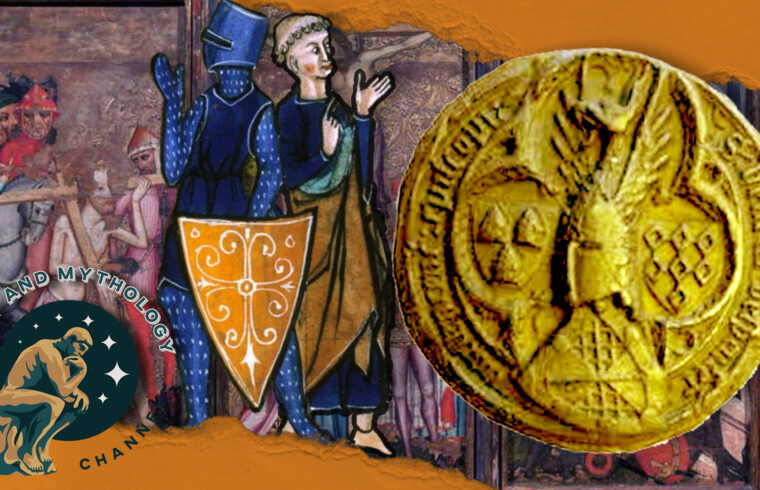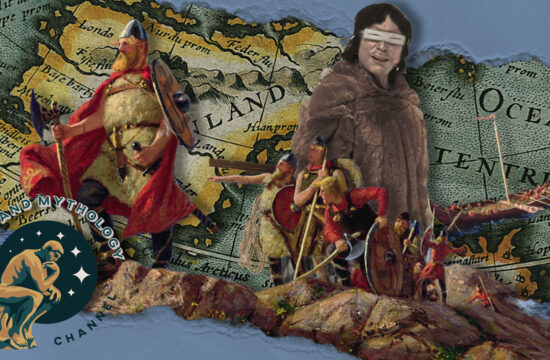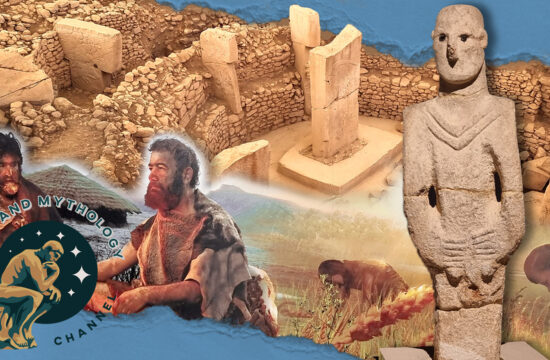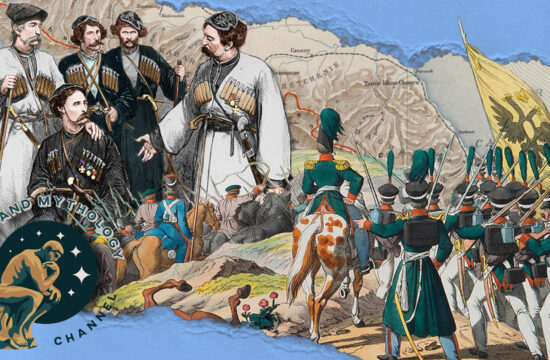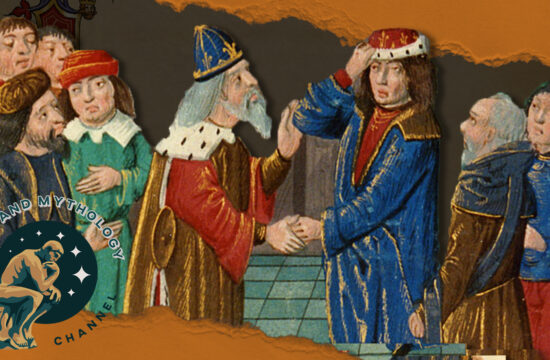Henry Dispenser, the Warrior Bishop (1342-1406)
Four years after the death of the mighty Edward III and a year after the Breton campaign of the Hundred Years’ War, a great peasant revolt broke out in England. The free but poor and indebted farmers, fed up with being harassed for their perpetually unpaid taxes, began to attack monasteries, town halls, even castles and universities en masse, to burn charters and registers of their debts to the aristocracy, the commons and the clergy.
Some nobles and clergy tried unsuccessfully to negotiate with their peasants. Others fled. Still others perished. But not Henry Dispenser, the Bishop of Norwich. Henry got his long-awaited chance to prove himself as a soldier after ten years of reluctant service as a clergyman.
Henry was a nobleman, born in 1342, the year his father, Edward, was killed during a siege in France. He was four or five years old when the Black Death swept through Western Europe, but he survived with all his relatives. His entire family had a strong military tradition. Henry had at least three brothers who were initiated into knighthood. However, he himself was destined by his family for a career as a clergyman and was sent to study first in Paris and then in Italy. This decision proved to be not to his liking.
Student and mercenary
On the peninsula, Henry did not spend much time in lecture halls and libraries. Instead, he joined one of the endless local wars on the side of Pope Urban V against Milan. As a young soldier, later initiated into a knighthood and commander of a small band of mercenaries, he participated in several small Italian battles and forever developed a taste for military life.
He outlived his brothers Hugh, Gilbert and Edward, who died bravely one after another on various battlefields in Italy and France. All this bloodthirsty family history does not prevent our Henry’s grandfather, the old Baron Hugh Dispenser, from being one of the handsome favorites of the notoriously gentle King Edward II.
Knight and Bishop
By 1362, the twenty-year-old Henry, who had acquired more military than spiritual experience, had already received several church sinecures and was even considered a master of law. He traveled a lot in Italy, regularly participated in military operations, received a knighthood at the same time as the privileges of a canon, and was actually pleased with the episcopal mitre in 1370, when he had already become famous as a successful warrior in Lombardy and Tuscany, almost like the notorious Sir John Hawkwood.
In fact, the young man’s family was horrified that he had abandoned a religious career and was risking his life. His older living relatives literally used their connections and money to procure for him the episcopal see he did not want. However, the income from the diocese could not be lightly rejected. Henry Dispenser reluctantly left the papal camp with thanks and went to take up his see at Norwich. His relatives had begged for the episcopal see for him precisely in order to force him to finally accept the clergy. A perfect example of a career forced upon him by overzealous well-wishers.
Henry’s next decade consisted mainly of hunting, feasting, lance training, and other feudal pleasures. His duties as bishop were systematically delegated to vicars. Life is gradually heading towards its natural, long sunset amidst a pleasant routine, when the Peasants’ Revolt of 1381 breaks out and Henry gets the long-awaited opportunity to prove himself as a soldier again.
The Peasants’ Revolt
The rebels are not particularly organized, but they are numerous and desperate. They attack Oxford University and at one point they start burning not only tax registers, but also all kinds of manuscripts out of hatred for the learned class. The suspicion of the stunned authorities is that the Lollard sect is encouraging the peasantry against the clergy. A particularly daring group of rebels invades the streets of London and takes over the Tower. Very young, King Richard II is forced to talk to them and beg them not to commit atrocities against women and children, and even personally addresses the peasant leader Wat Tyler. This humiliation will not be forgotten.
On 14 June a band of peasants reached Thetford and entered Norfolk. A local cloth dyer named Geoffrey Litster joined the rebels and began to encourage his countrymen to join in the fun. A few days later the city of Norwich was taken and sacked by the furious mob. Registers, documents of all kinds and the houses of the wealthier citizens and nobles were burned everywhere. During these events, the good Bishop Henry was at one of his country estates outside the city. On hearing of the chaos in Norwich, he armed himself with eight other cavalrymen and a not much larger number of archers and immediately set off for the seat of his diocese. While the rebels were dragging themselves as if towards Yarmouth, the bishop and his little, armed to the teeth, passed through Peterborough, Cambridge and Newmarket, collecting volunteers for a massacre among the local aggrieved citizens. The bishop and his followers overtook the peasant militia on 25 June near the village of North Walsham.
The peasant leader Geoffrey Litster was already called “King of the Commons” by his companions. His crowd consisted of perhaps over two thousand men, who had abandoned their huts and families: too many for a band of robbers, and who had already gathered arms and gained confidence from the plundering of a number of towns. The bishop’s archers and the town militia hastily attacked the peasants’ fortified position with a rampart. Henry himself and his small cavalry (nine men in all) charged into the crowd at full speed with pikes and then cut them down mercilessly with axes. The cavalry charge ended the peasants’ attempt at open battle. Many of the rebelling peasants laid down their arms and survived as prisoners, and were later enslaved under harsh conditions as debtors and pardoned traitors. Geoffrey the Painter fled, and his companions quickly dispersed. After this brief clash, the nobles began to return to their surrounding estates and set about the far easier task of hunting down the fleeing rebels. A few days later, Geoffrey was captured and torn between four horses. It is curious that the general-bishop Henry heard the confession and pardoned his opponent before sending him to execution. The “Anonymous Chronicle”, the chronicle of Thomas Walsingham, and the slightly later “Book of the Illustrious Henrys” by John Capgrave confirm that the bishop earned a formidable reputation as a warrior and judge. The following year, some of the surviving rebels even tried to organize an assassination attempt on the cruel cleric, but he learned of the plot in time and did not even bother to deal with his unnecessarily audacious enemies himself, but handed them over to the restored secular authorities. After his success against the rebellion, Henry commissioned a remarkable series of five sacral panels or paintings depicting the Passion of Christ for his cathedral in Norwich. His idea was that everyone who saw the panels would accept their fate as the suffering Christ accepted His: an undoubted message to the peasants not to allow themselves any more doomed attempts against the knightly hand of their bishop.
Crusader
Richard II and his parliament realized that a dangerous man like Henry should not be left for long without engagements of his own choosing. They found him a new military task: in 1383 he was sent to help the Flemish city of Ghent against the supporters of the Avignon antipope Clement VII in the Great Western Schism.
At the beginning of the Hundred Years’ War, the seat of the Holy See was in the southern French city of Avignon: Rome formally remained the domain of the Holy Father, but it was a very dangerous city, and the French kings also wanted to control the popes. In the course of the war, with a series of French defeats by the English, individual provinces of France began to secede from the great Western European monarchy. The conflict for the French throne turned into a series of chaotic civil wars. Some of the cardinals of the Roman Curia decided that France had already lost its importance as the protector of the Holy See, announced the return of the pope from Avignon (or Babylonian) captivity to Rome and nominated their own candidate. Western Europe immediately split into factions supporting either the Avignon or the Roman pope. The English, of course, supported Rome against France, and Henry was sent to help the anti-French rebels in Flanders. He showed imagination: an old defender of papal interests since his youth in Italy, Bishop Dispenser loudly declared in his cathedral at Norwich that he was going not just to war, but to a crusade against the enemies of Christianity. And, in accordance with an old tradition, he announced absolution for all who went with him.
There was no shortage of candidates for glory. Much of England’s continental trade passed through Flanders, and in particular through the thriving city of Ghent. So Parliament allocated funds for the pious Christian cause, and the soldiers, in need of forgiveness before God and the secular authorities, were not late for muster. The bishop refused to accept other nobles in command and accepted not only parliamentary assistance in money, but also raised funds himself, turning to merchants and guilds. Meanwhile, the Flemish leader Philip van Artevelde fortified Ghent in anticipation of the inevitable attack of the Clementists, that is, the pro-French party.
Not everyone in England wanted to sacrifice their wealth for the good bishop’s crusade. The preacher John Wycliffe repeatedly declared that the whole undertaking was purely secular and had nothing to do with the cause of God. Henry was unimpressed and solemnly declared that his men would fight only against the supporters of the false pope, in defense of the true faith. Meanwhile, priests, preachers, and indulgence sellers collected funds with commendable persistence and sometimes with threats. The treasury duly supplied bundles of arrows for the fearsome English archers.
The crusaders, wearing red crosses on a white background on their shoulders – a symbol that gradually transformed from a purely religious to a national emblem – assembled at Sandwich in late April 1383. At the last moment, King Richard II, trying to secure peace with France, sent orders not to set out until envoys returned from Paris, but the bishop had no time and was in debt. The weather was good, supplies were replenished, ships were available, and Henry Dispenser simply ignored his king’s order. He would later claim that he had set out before receiving it. The fleet set sail on 16 May.
By the end of the month, the entire army had landed at Calais, had already made contact with the Ghent militia, and had captured the town of Gravelines, not far from Dunkirk. For the next two months, the crusaders and their allies from the good city of Ghent laid siege to Ypres. However, Ypres was well fortified and the French would not surrender. The quick hopes of success turned into a long wait in front of an impregnable city. Some of the English volunteers, who had set out in the hope of plunder, began to desert. Others rioted in the area and got into scandals with their Ghent allies. Finally, a large part of the irregular troops was disbanded by order of the bishop. Meanwhile, in London, people began to wonder whether it had been a good idea to send Henry at the head of an entire army that was clearly achieving nothing substantial and was costing him dearly.
In September, when the army’s supplies were running low, Henry received permission from the king to retreat back to the sea. The English burned the captured Gravelines and abandoned Van Artevelde’s Ghent militia. The bishop returned without any major casualties, but also without victory, and the costs were serious. His army of about two thousand men disbanded on its own once it set foot on English soil. Henry himself was summoned to Westminster, accused of taking bribes from the French, but was convicted only for not accepting another nobleman as his assistant in command. He was fined a large sum and deprived of his income and rents for the next two years. Some of the knights who traveled with Henry and held officer positions in his crusading army were also convicted. At least one of them spent some time in prison, but was not fined, because he successfully argued in his defense that he had accepted a bribe from the French… only because he had lost valuable horses, weapons, armor and other baggage at the siege of Ypres.
Despite his financial losses, Henry recovered and in 1385 took part in another military campaign. Together with his king Richard II, the good bishop took part in a campaign against Scotland and successfully participated in the sack of Edinburgh, which somewhat compensated for his previous expenses.
Henry’s next years were occupied with disputes with the clergy in his diocese of Norwich. The militant and energetic, but already aging clergyman interfered too diligently in the daily affairs of his subordinate abbots and priests, so that they sought support from Rome against his constant encroachments. Between 1394 and 1401, the bishop managed, with patience, persistence, insolence, as well as simply ignoring the decisions of Rome and Canterbury, to establish himself as absolute master over the formally autonomous monasteries in his small area in East Anglia. All the while, he persecuted the Lollard heretics and on several occasions sent heretical preachers to the stake and the scaffold. During this time, the bishop’s nephews rose to prominence as valuable defenders of Richard II’s rule.
Troubles with the Law
In 1399, King Richard’s uncle, John of Gaunt (or John of Gaunt), died. The king immediately took the Duchy of Lancaster from John’s son, his cousin Henry Bolingbroke. Bolingbroke went into exile, but quickly returned with an army of discontented people. Richard, in turn, immediately returned from Ireland, where he had been dealing with local rebels, and tried to gather what part of the nobility remained loyal to him. The bishop was loyal to his rightful monarch (and to his relatives), so he set out with an armed band to join the forces coming from Ireland. Henry traveled with Edmund Langley, Duke of York. Langley, however, accepted Bolingbroke’s offers and went over to his side. As a true knight, Bishop Henry refused to go over to the traitors and was arrested. Soon after the capture and abdication of Richard II, the bishop was released and returned home. In the autumn of the same eventful year, he even attended the first parliament of the usurper Henry IV. The parliament decided that the deposed king should be imprisoned, and the bishop resigned himself to the course of events.
The following year, 1400, very soon after the Christmas visit of the Byzantine emperor Manuel II, an attempt to overthrow the usurper broke out in England. Henry IV was to be captured during a tournament. However, the Epiphany rebellion failed due to treachery. Our bishop’s nephew, Thomas Dispenser, who had been made Earl of Gloucester after his assistance to Richard II in the 80s, was executed for his part in the current conspiracy. Realizing where things were going, Henry left his diocese of Norwich in the hands of his deputy and went to plead his case before Parliament in London. There he was accused of treason against the new king, but managed to defend himself, reconciled with the Lancastrian monarch and returned home. Henry IV decided that he could not afford to keep Richard II alive and ordered the deposed king to be killed in Pontefract Castle to stop the rebellions and conspiracies.
The last five years of the Bishop of Norwich’s life were unusually peaceful. He spent his time between the cathedral and his several estates, spared from the storms of the age, although he himself had participated in them enough. He died on 26 August 1406 and was buried in front of the central altar of the main church in his diocese. An impression of his seal has been preserved, which shows something of his extraordinary personality: on the coat of arms there is a helmet combined with a mitre and decorated with an image of a griffin.

